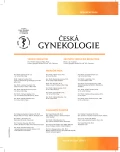Obstetric anal sphincter injuries – review of our date between 2015–2017
Authors:
M. Lincová; H. Neumannová; I. Mikysková; Michal Zikán
Authors‘ workplace:
Gynekologicko-porodnická klinika 1. LF UK a Nemocnice Na Bulovce, Praha, přednosta prof. MUDr. M. Zikán, Ph. D.
Published in:
Ceska Gynekol 2019; 84(1): 18-22
Category:
Overview
Objective: Analysis of women undergoing vaginal birth with 3rd or 4th degree perineal tears.
Type of study: Review and analysis of the data from our department.
Setting: Department of Gynecology and Obstetrics, 1st Medical Faculty of Charles University and Hospital Na Bulovce, Prague.
Introduction: Obstetric anal sphincter injuries (OASIS) belong to dreaded complications after vaginal delivery. The injury is associated with significant maternal morbidity. The most common difficulties are perineal pain, dyspareunia, flatulence and anal incontinence. OASIS are main cause of anal incontinence in women.
Main results: During monitored period 2015–2017 we performed 6185 childbirths in our ward. Cesarean section was performed at 21% of births, instrumental vaginal birth at 5,7% and 73,3% of women had a spontaneous vaginal birth. Our analysis included 4888 births. In our group 92,8% of women gave birth spontaneously regardless of injury and at 7,2% we performed an instrumental delivery. Perineal tears of 3rd and 4th degree were detected in 1,7% (83/4888) of vaginal births independent of vaginal ending. 85,5% were nulliparous women. In a group of instrumental deliveries the risk of OASI was higher. We have detected injury at 5,4% (19/352) of this type of delivery. The most detected perineal trauma in 47% was injury involving more than 50% of external anal sphincter thickness torn (3b). Surprising was a high incidence of mediolateral episiotomy in a group of women who sustained OASI. The most frequent symptoms three months after birth were flatus incontinence and dyspareunia.
Conclusion: Obstetric anal sphincter injury is associated with significant maternal morbidity. The most serious consequence is an anal incontinence. With other symptoms as a dyspareunia and a perineal pain it leads to psychosocial problems. Thorough treatment reduces the risk of complications.
Keywords:
obstetrics anal sphincter injuries – OASIS – episiotomy – instrumental vaginal delivery – spontaneous vaginal delivery
Sources
1. Aesheim, V., Nilsem, ABV., Reinar, LM., Lukasse, M. Perineal techniques during the second stage of labour for reducing perineal trauma. [online] In: Cochrane Database Syst rev. 2017 Jun 13; (6): CD006672.
2. Doležal, A., et al. Porodnické operace. 1. vyd. Praha: Grada, 2007, s. 36–41, 60–67.
3. Fernando, RJ., Sultan, AH., Kettle, C., Thakar, R. Methods of repair for obstetric anal sphincter injury. [online] In: Cochrane Database Syst Rev. 2013 Dec 8(12): CD002866.
4. Halaška, M., et al. Urogynekologie. 1. vyd. Praha: Galén, 2004, s. 173–177.
5. Jinag, H., Qian, X., Carrol, G., Gartner, P. Selective versus routine use of episiotomy for vaginal birth. [online] In: Cochrane Database Systematic Review - Intervention Version published: 08 February 2017, DOI:10.1002/14651858.CD000081.pub3.
6. Kalis, V., Laine, K., de Leeuw, J., et al. Classification of episiotomy: towards a standardisation of terminology. [ online] In: BJOG, 2012, 119, p. 522–526.
7. Kalis, V., Landsmanova, J., Bednarova, B., et al. Evaluation of the incision angle of mediolateral episiotomy at 60 degrees. [online] In: Int J Gynaecol Obstet, 2011, 112(3), p. 220–224. doi: 10.1016/j.ijgo.2010.09.015. Epub 2011 Jan 17.
8. Kapoor, DS., Thakar, R., Sultan, AH. Obstetric anal sphincter injuries: review of anatomical factors and modifiable second stage interventions. [online] In: Int Urogynecol J, 2015, 26(12), p. 1725–1734.
9. Karbanova, J., Rusavy, Z., Betincova, L., et al. Clinical evaluation of peripartum outcomes of mediolateral versus lateral episiotomy. [online] In: Int J Gynaecol Obstet, 2014, 124(1), p. 72–76. doi: 10.1016/j.ijgo.2013.07.011. Epub 2013 Sep 25.
10. Paka, C., Atan, IK., Dietz, HP. The bother of anal incontinence and St. Mark´s Incontinence Score. [online] In: Tech Coloproctol, 2016, 20, p. 123–128.
11. Pařízek, A., et al. Kritické stavy v porodnictví. 1. vyd. Kamenice/Praha: MCC Publishing/Galén, 2012, s. 138–143.
12. Rušavý, Z., Karbanová, J., Bednářová, B., Kališ, V. Ritgenův manévr a jeho modifikace. Čes Gynek, 2014, 79(1), s. 64–67.
13. van Bavel, J., et al. The effectiveness of mediolateral episiotomy in preventing obstetric anal sphincter injuries during operative vaginal delivery: a ten-year analysis of a national registry. [online] In: Int Urogynecol J, 2018, 29(3), p. 407–413.
14. Verghese, TS., Champaneria, R., Kapoor, DS., Latthe, PM. Obstetric anal sphincter injuries after episiotomy: systematic review and meta-analysis. [online] In: Int Urogynecol J, 2013, 27(10), p. 1459–1467.
15. Walsh, KA., Grivell, RM. Use of endoanal ultrasound for reducing the risk of complications related to anal sphincter injury after vaginal birth. [online] In: Cochrane Database Syst Rev, 2015, 29(10): CD010826.
Labels
Paediatric gynaecology Gynaecology and obstetrics Reproduction medicineArticle was published in
Czech Gynaecology

2019 Issue 1
Most read in this issue
- Endometriosis in pregnancy – diagnostics and management
- Diagnostics and modern trends in therapy of postpartum depression
- Cervical cerclage – history and contemporary use
- Uterine microbiome and endometrial receptivity
